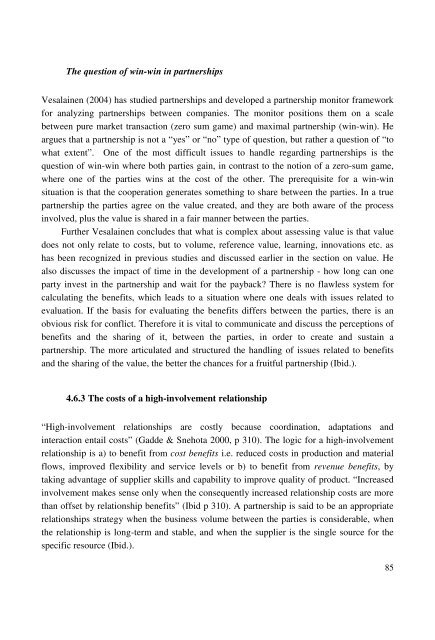Value Co-Creation in Industrial Buyer-Seller Partnerships ... - Doria
Value Co-Creation in Industrial Buyer-Seller Partnerships ... - Doria
Value Co-Creation in Industrial Buyer-Seller Partnerships ... - Doria
- No tags were found...
Create successful ePaper yourself
Turn your PDF publications into a flip-book with our unique Google optimized e-Paper software.
The question of w<strong>in</strong>-w<strong>in</strong> <strong>in</strong> partnershipsVesala<strong>in</strong>en (2004) has studied partnerships and developed a partnership monitor frameworkfor analyz<strong>in</strong>g partnerships between companies. The monitor positions them on a scalebetween pure market transaction (zero sum game) and maximal partnership (w<strong>in</strong>-w<strong>in</strong>). Heargues that a partnership is not a “ yes” or “ no” type of question, but rather a question of “ towhat extent” . One of the most difficult issues to handle regard<strong>in</strong>g partnerships is thequestion of w<strong>in</strong>-w<strong>in</strong> where both parties ga<strong>in</strong>, <strong>in</strong> contrast to the notion of a zero-sum game,where one of the parties w<strong>in</strong>s at the cost of the other. The prerequisite for a w<strong>in</strong>-w<strong>in</strong>situation is that the cooperation generates someth<strong>in</strong>g to share between the parties. In a truepartnership the parties agree on the value created, and they are both aware of the process<strong>in</strong>volved, plus the value is shared <strong>in</strong> a fair manner between the parties.Further Vesala<strong>in</strong>en concludes that what is complex about assess<strong>in</strong>g value is that valuedoes not only relate to costs, but to volume, reference value, learn<strong>in</strong>g, <strong>in</strong>novations etc. ashas been recognized <strong>in</strong> previous studies and discussed earlier <strong>in</strong> the section on value. Healso discusses the impact of time <strong>in</strong> the development of a partnership - how long can oneparty <strong>in</strong>vest <strong>in</strong> the partnership and wait for the payback? There is no flawless system forcalculat<strong>in</strong>g the benefits, which leads to a situation where one deals with issues related toevaluation. If the basis for evaluat<strong>in</strong>g the benefits differs between the parties, there is anobvious risk for conflict. Therefore it is vital to communicate and discuss the perceptions ofbenefits and the shar<strong>in</strong>g of it, between the parties, <strong>in</strong> order to create and susta<strong>in</strong> apartnership. The more articulated and structured the handl<strong>in</strong>g of issues related to benefitsand the shar<strong>in</strong>g of the value, the better the chances for a fruitful partnership (Ibid.).4.6.3 The costs of a high-<strong>in</strong>volvement relationship“ High-<strong>in</strong>volvement relationships are costly because coord<strong>in</strong>ation, adaptations and<strong>in</strong>teraction entail costs” (Gadde & Snehota 2000, p 310). The logic for a high-<strong>in</strong>volvementrelationship is a) to benefit from cost benefits i.e. reduced costs <strong>in</strong> production and materialflows, improved flexibility and service levels or b) to benefit from revenue benefits, bytak<strong>in</strong>g advantage of supplier skills and capability to improve quality of product. “ Increased<strong>in</strong>volvement makes sense only when the consequently <strong>in</strong>creased relationship costs are morethan offset by relationship benefits” (Ibid p 310). A partnership is said to be an appropriaterelationships strategy when the bus<strong>in</strong>ess volume between the parties is considerable, whenthe relationship is long-term and stable, and when the supplier is the s<strong>in</strong>gle source for thespecific resource (Ibid.).85
















